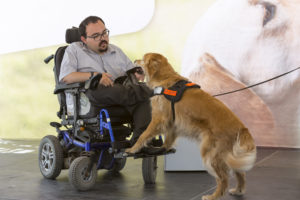
Reframing Animals and Access
Melanie Thornton, Coordinator of Access and Equity Outreach
University of Arkansas Partners of Inclusive Communities
Those of us who work at the intersection of disability and access are fortunate to have the exciting opportunity to create a more socially just world. We work to remove barriers that have historically limited the full participation of people with disabilities in society. As we do this important work, we are reminded that, despite the fact that almost 30 years have passed since the Americans with Disabilities Act was enacted, we are a long way away from the vision of seamless access. It seems clear that public perception of disability and access remains one of the greatest barriers to “the shameless wall of exclusion…tumbling down.”

I believe that an important part of the role of disability service providers is to change societal perceptions in ways that result in greater access and inclusion. In the past few years, the media stories highlighting nondisabled people who are claiming disability in order to bypass “no pet” policies in housing and on airlines has had a negative impact on disabled people who use service animals and ESAs. I see it as our role to counter these narratives with the reality that service animals and ESAs do in fact remove barriers for disabled people in meaningful ways. Yet, as I have seen exchanges (in email and in presentations) between professionals about animals and access, I have had concerns that we are not doing enough to counter the dominant narrative. And in fact, professionals are at times saying things that support a narrative that makes it more difficult for disabled people using service animals or ESAs to gain access.
What can we do to change the conversation? Here are a few suggestions:
- Get clear on the definitions of service animals and emotional support animals. I often see questions or comments that confuse the two. Since the process and laws are different, confusing the two is likely to result in discrimination toward someone with a service animal. And if we are sharing conflicting information and using conflicting terminology, imagine how confused others on our campus will be.
- Inform employees that having a service animal in any area where the public is allowed is a civil right. Creating an atmosphere where people who use service animals can come and go freely without being questioned or harassed should be a top priority. That commitment should be higher than the commitment to keep people from bringing pets on campus. Some campuses have decided to take this approach: When a person has a dog in a public area or classroom and the dog is well-behaved, they assume it is a service dog. Sure, occasionally a pet may be brought to campus and pass as a service dog. Better that than a person with a disability having to answer the allowed questions over and over again.
- Remember that a service animal is a service animal is a service animal. Whether a service animal performs a task for someone who is deaf or blind or has a psychiatric condition, the person’s rights are exactly the same. If the task involves recognition and response, it does not matter what the task is or what the disability is, the person has the same rights.
- Approach requests for emotional support animals in the same way other requests for accommodations are approached. Just as with any other accommodation, determining whether the “no pet” rule should be waived for a person requesting an ESA requires the same process: What is the student’s disability? What is the barrier the student is experiencing? What is the link between the barrier and the disability? How does the presence of the ESA alleviate that barrier? If more information is needed to answer these questions, request it from the student or a professional that the student has worked with. Just because the student brings in a letter stating that an ESA has been recommended does not mean you have to, or should, bypass the interactive process.
- Remember that ESAs can be any species. The Fair Housing Act does not limit the species as long as the animal does not pose a threat to people or the facility. There is no reason to ask if a certain species is allowable or not. If there is no threat and the animal has been determined to be a reasonable accommodation through an interactive process, allow it.
- Make sure policies and practices are not more restrictive than what the law allows. It seems a lot of campuses are creating policies related to animals and access. When a campus does this, it runs the risk of creating an environment that is more restrictive than the law and that results in discrimination. It is also important to avoid “blanket bans” and to remember that most decisions should be made on a case by case basis.
- Avoid making students who are using animals for access jump through unnecessary hoops. Just as with other accommodation requests, the role of disability service providers should be to remove barriers to access. Complicated processes create barriers for disabled students that nondisabled students do not encounter.
- Avoid making fun of requests for ESAs and service animals. Joking about animals and access runs the risk of creating an environment in which disabled people may be reluctant to request accommodations or obtain a service animal. I’ve spoken with a couple of people who use ESAs and who have felt humiliated and emotionally unsafe at recent conferences because disability service professionals were joking about ESAs in their presence. We can do better.
BOTTOM LINE: I would much rather risk allowing a pet to pass as a service animal or ESA than risk discriminating against a single person with a disability who is using a service animal or requesting an ESA as a reasonable accommodation. If you feel the same way, let’s work together to create a conversation around animals and access that models what we want to see in the world.
For more detailed information and resources about animals and access, see our June Issue of the Explore Access Update,
Upcoming Events
Free Webinar
Sponsored by Great Lakes ADA Center and the National ADA Network
Accessible Entrances, Doors, and Gates
Thursday, January 3, 2019
1:30 PM Central Time Zone
Register for the Accessible Entrances, Doors, and Gate Webinar here!
Free Webinar
Sponsored by Great Lakes ADA Center and the National ADA Network
Accommodating Students with Disabilities Enrolled in Medical and Health Science Programs
Tuesday, January 15, 2019
1:00 PM Central Time Zone
Register for the Accommodating Students in Medical and Health Science Programs Webinar here!
Free Webinar
Sponsored by TransCen Inc. and the Mid-Atlantic ADA Center
The Intersection of ADA, FMLA, and Workers’ Compensation
Thursday, January 17, 2019
1:00 PM Central Time Zone
Register for the Accommodating Students in Medical and Health Science Programs Webinar here!
Stay Connected with Us!
Enjoy getting resources on access an inclusion? Follow Partners for Inclusive Communities on Facebook and Twitter for more news and resources!
About Explore Access
exploreaccess.org is a web resource developed through a project of the Southwest ADA Center Regional Affiliate – Arkansas, a program of UA Partners for Inclusive Communities through funding from the Southwest ADA Center (90DP0092).
